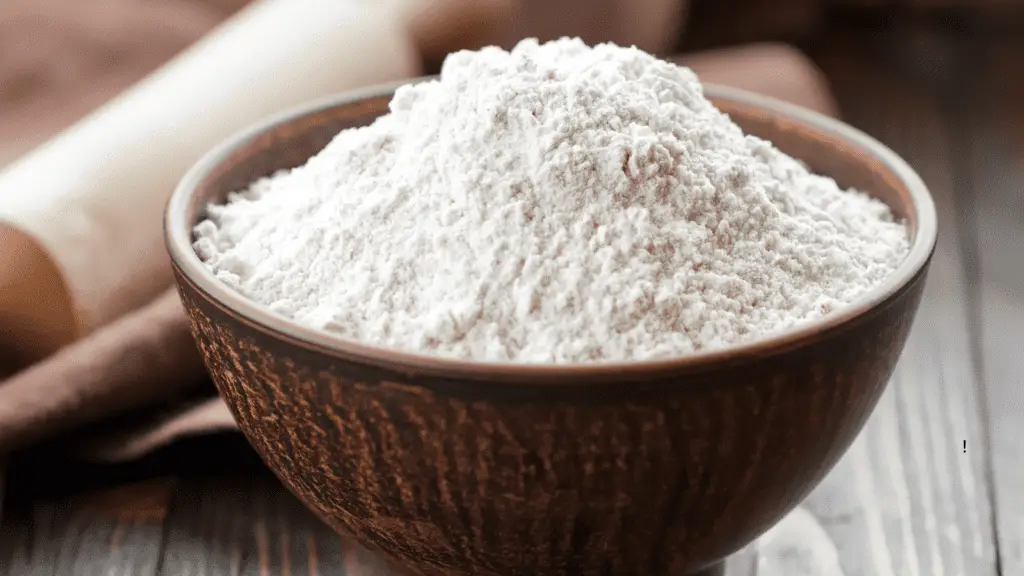Pizza is a classic and popular type of food consumed across the globe, and it’s not that hard to make.
Like the popular saying goes: Bad pizza is still good pizza.
But in order to make the perfect pizza at home, one still needs a bit of investment in the form of time and quality ingredients (and that also includes what goes into the pizza dough).
One of the most common types of flour used in pizza making is the pizza flour. But it isn’t the only type of flour that can be used to make pizza dough.
In this article we would discuss the possibilities of using bread flour as a pizza flour replacement and check out some of the impacts it may have on the final product.
We would also explore some alternatives that can can be used in place of pizza flour.

What Is Bread Flour? And Can It Be Used For Making Pizza Dough?
Bread flour, as the name implies, is a type of flour meant for use in bread making.
It is suitable for making bread because it has a higher protein content than other types of flour and also has a higher gluten content which means it is able to trap bubbles and lead to an airy and chewy crust after baking – something very desirable in breads.
The type of wheat commonly used for making bread flour is the hard wheat variety because of its higher protein content in comparison to soft wheat which is commonly used for flours like all purpose.
In making the flour, the bran and germ are separated from the endosperm which leaves a fine white powder that we know, classically, as flour.
The protein content of bread flour is typically in the range of 12 to 14% whereas that for all purpose flour made using soft wheat varieties has a protein content of 9 to 11%.
When it comes to pizza making, bread flour can be used in making the dough, but it will give rise to a chewier crust that is airy, with lots of bubbles inside of it.
Additionally, because of the high gluten nature of the flour, the dough made from it may be more difficult to work with, and the resulting crust may be less tender than if an unbleached all-purpose flour was used.
At the end of the day, the choice of pizza or bread dough for making pizza still boils down to personal preference.
Some people may like the light and airy texture provided by the bread flour, whereas others would frown at it. So try it, and see if it works for you.
Is Strong Bread Flour Good For Pizza Dough?
Strong flour or strong bread flour as it is sometimes called is best described as the umbrella term for all flours that are like the bread flour including the bread flour itself.
Strong flour is basically a flour that is made from hard wheat which naturally contain a higher amount of protein than soft wheat, and when used to make pizza dough, will result in a chewier and more structured dough.
From the definition above, it’s easy to see where the name “strong prefix” comes from — the fact that the dough is made using a hard wheat.
The higher protein content of strong flour also makes it beneficial for creating a crisp and sturdy crust which can easily support wet toppings like sauces and melted cheese without getting soggy.
How Is Pizza Flour Different From Bread Flour?
Pizza flour and bread flour are similar in many ways, and in fact, they share more similarities with each other than with the All-purpose flour.
They do, however, have some key differences that make them better suited for the specific type of applications that they were made for. Pizza in the case of pizza flour and bread in the case of bread flour.
To begin with, Pizza flour, also known as tipo “00” flour is a finely ground flour made from a soft wheat.
It has a high protein content, but a lower gluten content at the same time (because it is made using a soft wheat) which allows it to produces a crumb that is more tender and delicate compared to the bread flour.
This makes it ideal for making thin and crispy pizza crusts like the Neapolitan style pizza.
Bread flour on the other hand, is made from hard wheat varieties thus it has a higher protein and gluten content. This high gluten content ensures that end products bake with a chewier and more structured crumb ideal for bread making.
Unlike the pizza flour, bread flour isn’t able to deliver that delicate and crackly thin layer of crust associated with pizza flour.
Another key difference between pizza flour and bread flour lies in the way they are milled.
Pizza flour is milled very finely (which is where they get their 00 name from).
This fine grinding which gives it the consistency of a baby powder, makes it easier to work with.
Contrarily, bread flour is often milled with coarseness and its high protein content means that dough made with it will be somewhat difficult to work with.
As for taste, there really isn’t much difference to observe, except when you start out with a flour made with additives to influence its taste.
Which Flour Is Better For Pizza Dough?
What flour to use for pizza dough or which is better for it largely depends on the type of pizza you’re making and your personal preference — commonly gauged by factors such as the kind of texture and flavor you like.
There are many types of flour out there that you can use for pizza dough, but if i must recommend one for you that would always produce a pizza with great structure texture and taste all the time, it would be the 00 type.
However, other types of flours like the bread flour and All-Purpose flour in its bleached and unbleached form would do just fine and produce a decent result.
All-purpose flour, like the name suggests, is a flexible type of flour that can certainly be used for making pizza.
It has a moderate protein content, typically around 9-11%, which would result in a tender and slightly chewy crust when used for pizza crust that may not be desirable in certain styles of pizza like the Neapolitan Pizza. Yet, it would definitely fit sleek with other types of pizza styles.
The fact that it is widely available and affordable makes it even more attractive as a pizza flour alternative.
Frequently Asked Questions About Pizza Dough
What is the secret to making good pizza dough?
The secret to making a good pizza dough lies in the tips we’re about to share with you below
Select High Quality Ingredients
If you’re making pizza dough and you’re not starting out with high quality ingredients, then you’re doing it wrong and will probably end up with a disappointing crust.
When making pizza dough, ensure you’re not using expired box/container of pizza yeast (and flour), and opt for fresh ingredients for toppings such as cheese, herbs and seasoning.
Knack the right Moisturization
Getting the perfect balance of water to flour for your dough is absolutely critical in making a really good pizza.
When you have too much water, the dough comes out sticky and difficult to work with, while too little water would make it tough and dry. The right balance is what sits in between the two, and you can achieve that by the gradual addition of water or flour when you notice a skew.
Stick to the rise time specified by the recipe
When making pizza dough, allow it to rise for the duration of time specified by the recipe. This will allow the dough to develop flavor as well as texture.
When you under proof a dough, it can result in a dense crumb whereas over proofing your dough can make it fragile.
Use High Temperature
Pizza is a high heat dish, so make sure to use a hot oven in order to be able to produce a crust that is both crispy and brown.
Ensure to preheat the oven to the recommended temperature and use a pizza stone or steel to help transfer and distribute heat throughout the dough.
Follow a recipe, practice and then experiment:
Making good pizza dough takes practice and experiments, and you won’t ever get there without following a foolproof recipe in the first place.
Stick to a recipe until you perfect it, then begin trying out different types of flour and additives, ratios of ingredients (without altering flour and water ratios of course) and baking techniques to find what works best for you and your household.
What makes pizza dough more crispy?
Not everyone loves a crispy pizza, but for those that are head over heels for it, here are the things to do to ensure you always get one on your home-baked pizza.
Select the right type of flour
When it comes to baking pizza with a crispy crust, the first thing you should consider is the type of flour you’re using. Some flours, no matter what you do to then, would only produce a tender, moist and chewy result because of how they are chemically structured.
In order to bake a crispy pizza dough, you need a flour with a high protein content which will allow the production of a light and airy structure within the dough as it baked.
These types of flours include the bread flour as well as the pizza flour.
Spread the dough thin
It’s not just enough to get the flour selection right, you need to treat the resulting dough properly if you want a shot at a crispy result.
When it comes to spreading out the dough, make it thin so that it to cooks more quickly and evenly and produce a crispy crust in the process.
Don’t overload the pizza With Toppings
Having a lot going on on the surface of your pizza can make it soggy at the sides and surface which can result in a less crispy crust. So always try to stick to moderation as much as you can.
Heat
Heat is also a critical component for making a crispy crust on pizza. Whenever you’re making one, make sure to preheat the oven to the recommended temperature (at least 450°F or 232°C) and use a pizza stone to distribute heat throughout the dough.
Bake the pizza on a preheated surface
If using a pizza stone, preheat it in the oven for at least 30 minutes before placing the pizza on it. This will help transfer heat to the dough and create a crispier crust.
What is the best flour for achieving a thin crust pizza?
The best flour for achieving a thin crust pizza is the pizza flour — you weren’t expecting any thing other than that were you?
Second after it is the bread flour due to how similar they are at the molecular level.
The lower gluten content of pizza flour (around 8-12%) results in a tender crust that is crispy on the outside and soft on the inside. This is why it is used in Italy for making the Neapolitan-style pizza, which is characterized by a thin and crispy crust.
